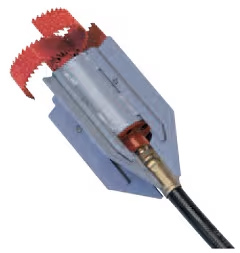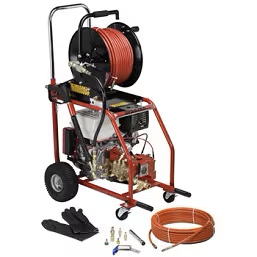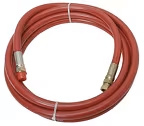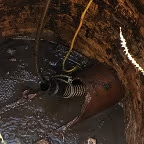Hydro-jetter usage is growing steadily as plumbers, drain cleaners, and building managers learn about its benefits. Hydro-jetters are relatively simple machines to understand and operate, and they can clean some drain obstructions much more efficiently than a standard cable machine. When should you choose a hydro-jetter and what types of drain cleaning jobs are best suited to their capabilities? A true professional will select the right tool for each drain cleaning situation they are facing.
Choosing the Right Tool for the Job
A basic rule of thumb applies when choosing between these two types of drain cleaning machines:
- Cable machines are designed to cut away hard obstructions in the sewer pipe, such as tree roots.
- Sewer jetters are designed to blast away soft obstructions, such as grease buildup.
As usual, there are sometimes exceptions to this rule – sometimes it may be necessary to use both a cable machine with a blade attached and a hydro-jetter with its high-pressure capability in order to effectively clear a pipe blockage. Let’s take a look at common residential and commercial applications for the sewer jetter.
Removing Hard Drain Obstructions
If the drain technician is working with tree roots in a residential sewer, the tool of choice is most likely a cable machine with a root cutting blade and attachment. The cable and blade is placed in the cleanout and the cable is sent down the pipe to cut out the roots.
A hydro-jetter can be used in conjunction with a hydraulic root cutter to cut away hard obstructions such as tree roots. The root cutter is manually attached to the end of the jetter hose, inserted in the pipe, and the pump is engaged. The water pressure and flow rotates the blade and the blade cuts the roots or other hard obstruction and clears the pipe.
Spartan Tool is the originator of the hydraulic root cutter, an unsurpassed tool for attacking heavily root-impacted sewer lines. These heat-treated saw blades are tough over the long haul, and the hydraulic motors that power them are designed to be operated at specific pressures and flows for hydro-jetters and sewer flushers. Unlike nozzles that try to pulverize roots, these cutters will cut, tear and yank on the roots to completely clear the line in short order.

Removing Soft Drain Obstructions
If the technician is working with soft grease in a restaurant kitchen drain pipe, a hydro-jetter is normally the tool of choice. The high-pressure water jets will stir up the grease and the water flow will carry the grease out of the pipe by gravity flow.
A soft grease blockage is a self-healing blockage. A cable and blade attachment will pass through the grease and the grease will simply close up behind it. Unless water can be introduced into the pipe, chances are good that whatever is causing the blockage will only be moved further down the pipe and not removed. Grease will often “set” and harden in the pipe. In these cases, a hydro-jetter that delivers less than 2,000 PSI will often have difficulty breaking up hardened grease clogs. Jetters with higher pressures will tend to do much better at breaking up these pockets of hard grease, and it may be necessary to employ both a cable machine to break up grease, and a sewer jetter to flush the pieces out of the pipe to finish the job.
Residential & Light Commercial Jetting Applications

Cleaning residential and smaller commercial drain systems is quite a bit different then cleaning municipal sewers. When using a hydro-jetter for these types of applications, a cleanout pipe or the plumbing fixture is usually accessed and the jetting is performed from the higher end to the lower end. The drain cleaning technician is cleaning from the top of the system. The top of the system is where the flow originates, in comparison to a manhole system which is cleaned from the lower end of the system.
The reason the procedure for cleaning smaller residential and commercial drains is different is because in a cleanout pipe or plumbing fixture, the technician can no longer put the hose into the pipe, let it enter the pipe for a distance and then retrieve the hose completely. The reason the technician cannot retrieve the hose is because the obstructions will be pulled back to the cleanout pipe or fixture, and the water pressure may blow the obstruction (and a lot of water) out of the pipe, causing possible injury and a large mess!
Municipal Sewer Jetting Applications
When a technician is called in for a stoppage in a municipal sewer, the first task is determining the direction of the wastewater flow. The water obviously flows downhill in a gravity based sewer, but that does not necessarily tell flow direction. Ideally, sewer jetting is performed in municipal sewers by placing the jetting hose in the lower manhole and jetting to the higher manhole. The water jet should break through the obstruction, open the pipe and enter the upstream manhole.
Once the hose and nozzle have passed completely through a blocked pipe to the next manhole, the cleaning process can begin. The rewinding of the hose, while the pressure is fully engaged, cleans the pipe. The pressure breaks loose the obstruction or buildup, and the water flow carries the debris away leaving a clean sewer pipe.
While cleaning municipal sewers with a high-pressure hydro-jetter, it is highly recommended to put a leader hose on the end of the high pressure jetting hose. The leader hose is typically a 10 - 15 foot long section of sewer jetting hose colored in a high contrast red or orange, with a coupling that connects to the end of the jetting hose. The leader hose will tell the operator when they are near the end of the pipe, allowing the operator to shut down the machine so the nozzle never leaves the pipe.


The hose guard is designed to protect the hose from sharp edges as it bends into the sewer line. The jetting hose is inserted into the hose guard and lowered into the manhole with the yellow rope, which makes retrieval quick and easy. In this photo, the leader hose is visible as it is retracted from the pipe. Although the red leader hose appears dirty from sewer water, it still contrasts with the black jetting hose and allows the operator to detect when to shut the water off.
 US Dollars
US Dollars

